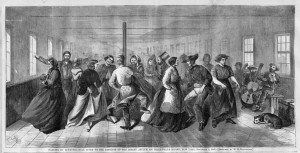
Blackwell’s Island Lunatic Ball, 1865
It is likely that all insane asylums held patients who managed to escape (see last post). These attempts were met with a variety of responses from the community. Especially in the earlier days of asylum-building, the institution’s affiliated city actively worked to bring the asylum in, and the townspeople were quite proud of their magnificent new structure and the asylum’s important work. Generally, citizens were both curious and sympathetic toward patients, and asylums often hosted community events like dances to help abate any fears concerning patients that townspeople might harbor. Sometimes townspeople became quite familiar with patients and called asylum staff when they noticed someone at large whom they didn’t think had parole privileges. Newspapers do not generally denote any particular hysteria or fear on the part of the public when a patient escaped, IF the patient was believed to be nonviolent. Asylums which housed the criminally insane or held patients known to have been violent before committal were viewed with some dismay on the part of townspeople. Word of an escape could wreak panic in that instance.
An Escaped Lunatic
Relatives were notified when a patient escaped, and institutions were charged with making every effort to find and return these patients to the asylum. However, patients often had time on their side. In the second annual report of the New York State Commission in Lunacy, 1890, guidelines were set for the length of time the asylum could (or should) pursue a patient’s return. Any patient who managed to remain free for 30 days had to be discharged from the asylum’s books and could not be readmitted without a new medical certificate. This provision derived from the belief that an insane person was “liable to recover at any time.” The intent of the commission was to make sure that an escaped patient was not subsequently committed when he or she was no longer insane.
Newspaper Account of Escape
______________________________________________________________________________________





